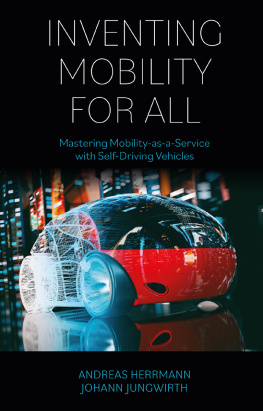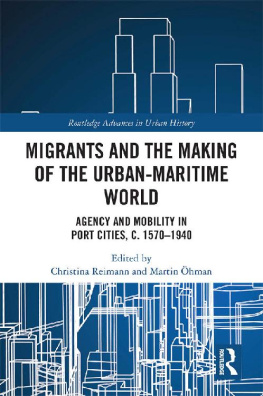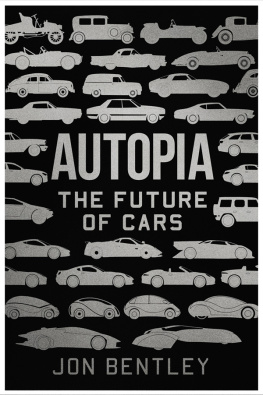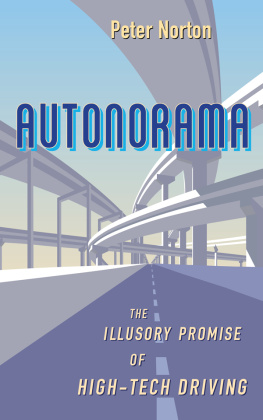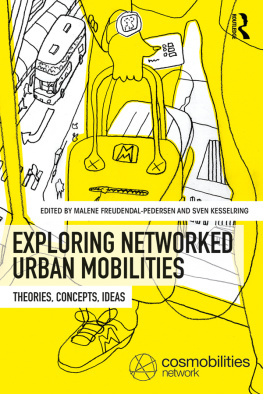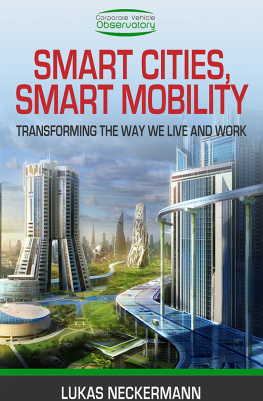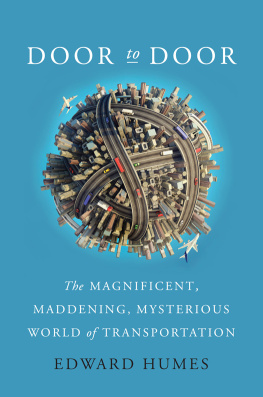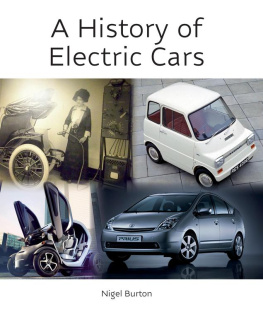Contents
To the young ones, Alex Rossant, Sloane Wright, and Louise Craver, who will have so many different choices when it comes to moving around.
Where have you been your whole life? Think of all the places: home, school, work, restaurants, the gym. Maybe Carnival in Rio, a cheap hotel in Paris? All those memories and routines involved moving your body from one place to another. Movement is such a constant in our lives that its easy to overlook. It occupies hours of each day and devours a good share of our money. Its central to our existence, nearly on a par with eating. If we didnt move, wed never see each other. Now, as we enter the third decade of the twenty-first century, the ways we move are changing dramatically.
At about this point, as we describe this book, people often interrupt and say, Driverless cars, right?
Whats coming is more than just one instance of robotic navigation, and much bigger. You can see it gearing up around the world. Overwhelmed by traffic and wheezing from smog, cities are confronting the limits of the century-old automobile economy and taking steps to rein it in. Many are extending greenways and building bike lanes. Some, like Madrid, are starting to ban cars altogether from city centers. Others are charging fees to drive in congested areas while presiding over a proliferation of bike- and car-shares. At the same time, a technology explosion is unleashing a new generation of networked machines and services. And yes, its true, the automobile, step-by-step, is turning into a robot.
The car we all know, the gas-gulping machine we drive, has had quite a century. Our urban geography has molded itself to its demands. Its networks of highways gave birth to new suburbs, while developers carved out vast downtown acreages for parking lots. Cities grew into planned preserves for countless herds of these four-wheeled creatures, Serengetis for cars and trucks. That automotive monoculture spread around the world, from Los Angeles and Caracas to Moscow and, more recently, Beijing and New Delhi. The car reshaped the surface of the planet and poisoned the air above.
While the automobile isnt going away, it is losing its primacy. Over the next decade, many of us will find new ways to move. This next stage of human mobility, unlike the last, will not be defined by a single iconic technology. Instead well be faced with a host of choices, most of them tracked and mediated by digital networks. Where it works, this arrangement will be greener, cheaper, faster, and safer than todays smoggy and gridlocked status quo. The financial impact, for everything from households to national economies, will be profound. Once again, mobility will reshuffle our industrial landscape, juggle the timetables of our lives, and reshape our cities. It will also weigh heavily, for better or worse, on the future of our planet.
Much of the change ahead is tied to digital knowledgea sprouting awareness of where we are, where we want to go, and whats available to take us there. This intelligence poses a profound contrast to the status quo of the automobile age, which has been marked by abject ignorance.
To recall just how little we knew, picture the outlaws Bonnie and Clyde on their murderous bank-robbing rampage through the Great Plains in the 1930s. They were driving on public highways, yet no one knew where they were. The police had to track down eyewitnesses and then stick time-colored pins in maps as they attempted to determine where the outlaws might be and where theyd strike next. Cars, for most of the century, were as footloose as hyenas. For millions of teenagers, this ignorance of whereabouts spelled freedom. We were out driving... somewhere. Our parents trusted we werent robbing banks. But they knew only vaguely, if at all, where we might be.
City planners were also in the dark. Until recently, highway engineers would stretch cords equipped with counting sensors across roads. This provided primitive insights, but only on the behavior of our motorized herds. And engineers had precious few tools with which to manage the flow. Traffic, like a force of nature, simply happened. So most cities bowed to its unrelenting pressure and dedicated big chunks of their budgets to widening roads and highways, and opening up more space for parking. The resulting status quo was rife with wasteof energy, time, and money. The massive backups, the crawling lines of single drivers in five-thousand-pound hunks of metal, epitomized its inefficiencies.
The abundant waste found in the ignorant status quo spells boundless opportunity. Planners and entrepreneurs alike can now measure and count all kinds of things. As they do, they can sharpen their focus from the herd to the individual. This fuels new businesses. A commuter in Paris, for example, inches along the clogged Boulevard Priphrique at the wheel of a Renault Clio. Say theres a service or an app that can slice a half hour off her commute, in each direction, freeing up five hours a week. What would she pay for those miles and minutes?
These are burgeoning markets of space and time. Most of them would have been beyond our reach until recently. But a host of enabling technologies are now at hand. Arrays of sensors can now provide second-by-second reads on our location. High-speed networks, including 5G, can zip that data to computing clouds. Advanced artificial intelligence can turn it into insights about where were goingand how best to get us there. Blockchain and other distributed ledger technologies, devised only a decade ago as the foundation for cryptocurrencies like Bitcoin, provide secure channels through which vehicles can share information and coordinate their actions. This sharing is fundamental for creating hyperefficient networkseven while were still behind the wheel.
One other fundamental technology is the battery. The new mobility machines run, for the most part, on electricity, which happens to be what computers eat. Most of the new conveyances, in essence, are networked computers fitted with wheels or wings. Even bikes are getting smart.
Mobility, as we see it, represents the third stage of the Internet. The networked age debuted in the final decade of the last century, when rich troves of information, from mail to music, went digital. In the following decade, with the explosion of smartphones, information went mobile. That was stage two. The marriage of the cell phone to a networked computer placed the universe of knowledge into our pockets and purses, and added what amounts to an electronic lobe to the human brain. Were now accustomed, and even addicted, to carrying around networked technology. As we embark on stage three, ever more advanced blends of that technology are carrying us around.
In the coming age of mobility, practically every rolling and flying conveyance will be a networked device. For a glimpse of what this means, open a ride-sharing app, such as Uber or Chinas DiDi. The dots on the screens provide a glimpse of the future, one in which each of us moves as a node on a network map.
Ride-sharing was the first big splash of a tech wave that had been hyped for two decades: the so-called Internet of Things. Refrigerators would order milk, we were told, and smart light bulbs would brighten when we walked into a room. A good number of these machine-to-machine applications are finally creeping into the marketplace. But the biggest and richest arena for the Internet of Things will be mobility. It dwarfs the rest of the field.
This doesnt mean that the next cars we buy will be driverless, or that well soon be gliding over rush hour traffic in autonomous flying pods. These technologies, as well see, are in the works and will indeed be lifting off, in some places much sooner than others. For most of us, though, the coming transition will begin not with a miraculous new machine at the curb, but with a series of new questions.


